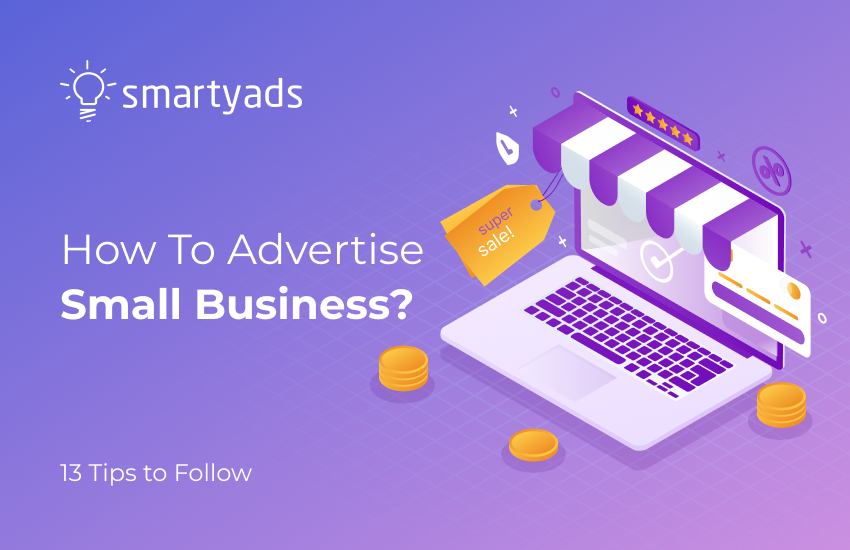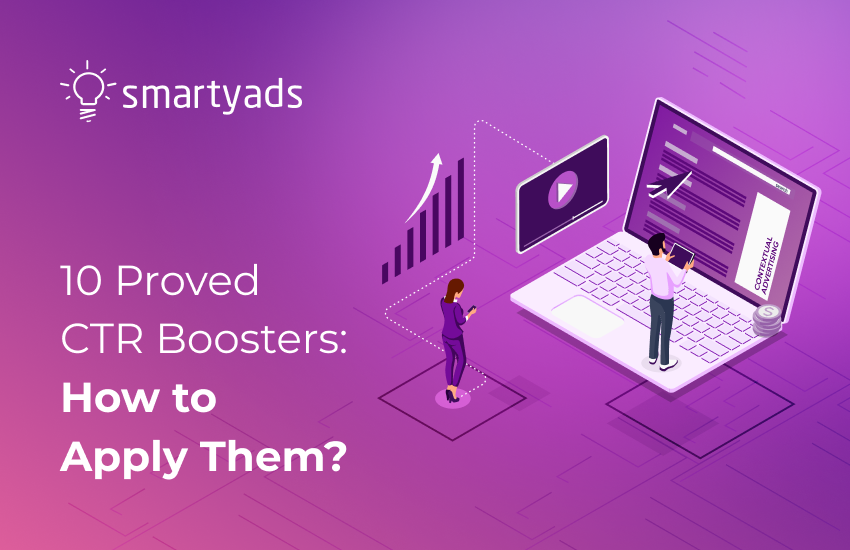Online advertising types are rapidly changing. At the dawn of online advertising, a good click-through rate might be a matter of placing a few banner ads on the landing pages, while now advertisers have to compete for user attention.
More and more types of online advertising are appearing on the Internet, and users are becoming increasingly pampered. It is no longer enough just to show a banner or a video about a product or a service; now, it has to be done at the right time and in the proper context. If ads for gas burners are adjacent to news about a wildfire, such an online advertising campaign can destroy your entire brand.
You can use social media platforms or programmatic platforms to display advertising. These allow advertisers to place almost any type of ad in any location available.
In addition, you need to have a variety of ads; they need to be presented in a diversity of formats. This is important not only because multiple formats increase your audience reach but also because you can understand what types of online advertising work best for your product. In this article, we will talk about the kinds of Internet advertising that are highly likely to be the most productive in the near future.
Overall, there are eight types of online advertising performing best in 2023 so we expect for the same trend in 2024 (5 core ad types + 3 rising stars):
- Native advertising;
- Video ads;
- Display ads;
- Full-screen interstitials;
- Expandable ads;
- Audio ads and CTV;
- DOOH ads;
- In-game ads.
Online media now define creative formats and mediums where display ads must be served. The "Windows 95" era might be a cool time, but today advertisers and publishers have completely different game rules to adapt to in order to make online advertising work.
If you can't choose between types of digital ads for your ad campaign, the first thing on your mind will probably be their cost per click or cost per mile. So, you will be right, but only partly, because good creative also resonates with the users; it's memorable and brings conversions well when the traffic comes from the relevant landing pages.
Types of Internet advertising winning the world
The effectiveness of online advertising may depend on different things. Specific forms of online advertising showed impeccable efficiency in the 2020-2023 years because of the factors we will describe below in detail.
We suppose that those ad types we've mentioned earlier will produce approximately the same CTRs as we've seen in 2023:
- native advertising — a leader among leaders that typically generates 10.4% CTR;
- the full-screen interstitial follows with 5-7%;
- video and expandable ads closed the list with a 1.2% CTR.
To meet its needs, online advertising can use almost any media. Media, including print, television, radio, movies, outdoor advertising, mobile devices, and digital technology, are targets for advertisers.
Digital ad spending by formats 2024 - 2028
Anticipated growth is expected in ad spending across all segments in 2024 - 2028. Reflecting this positive trajectory, each of the four segments is projected to reach its peak value by the conclusion of the comparison period. Notably, the Search Advertising segment stands out with the highest value, reaching 417.39 billion U.S. dollars.
Sizes
The most common misconception is that all advertisers want to serve the users large creatives placed at the top of a web page or occupy the whole screen. Indeed, sometimes creatives in online advertising show the best results at the very bottom of the page or in the middle.
But in reality, huge online advertising banners that interfere with viewing the main content only cause irritation and force users to use ad blockers more actively. So it's better to act in the interests of both the brand and the user. Because, in essence, the user's desire equals the benefit to the brand.
Internet advertising is best placed alongside content that can resonate with it, and then it won't really matter what size your banner ad is.
For instance, when the creative is located under an informative article that facilitates decision-making. Smaller ad units, in turn, can deliver much better results because they are non-intrusive and contain engaging and interesting content.
As users massively shifted from their personal computers to smartphones, the mobile ecosystem has become the most fruitful ground for advertisers who strive to achieve higher ROI using affordable small and medium ad formats.
Native ads
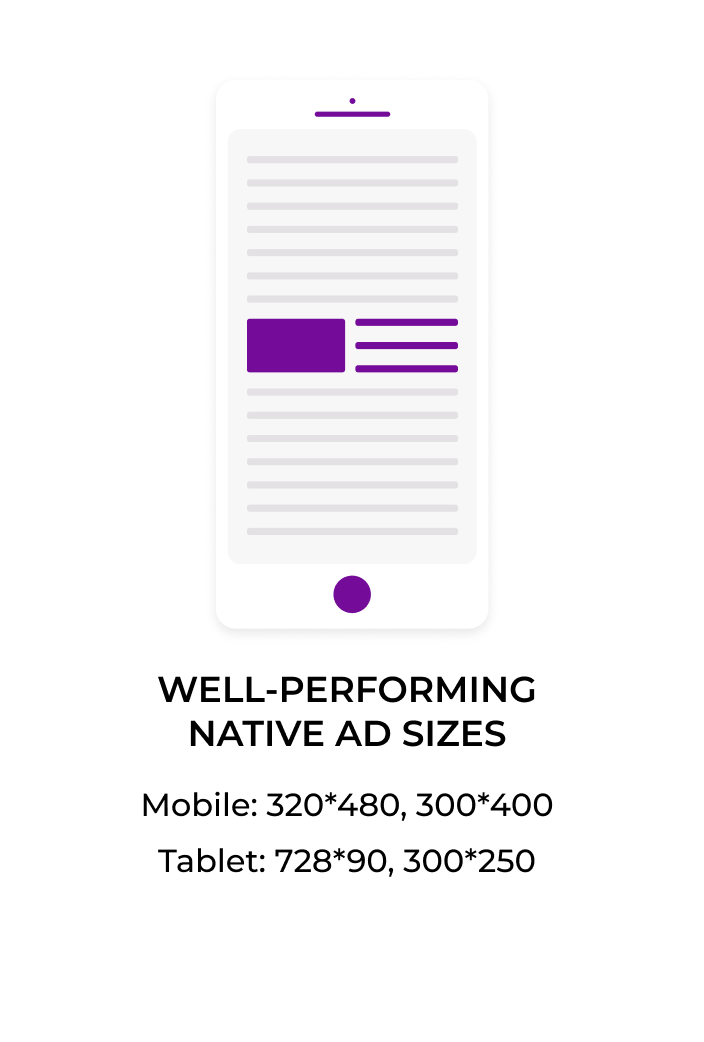 Native forms of online advertising are those ad units that blend with the rest of the content on the landing pages, imitating their interface, design, and functions.
Native forms of online advertising are those ad units that blend with the rest of the content on the landing pages, imitating their interface, design, and functions.
Native digital advertising appeared not long ago when it turned out that banners are no longer functional because of their aggressive approach, flashy creatives that distort the website's interface, and "banner blindness".
The most common native ads are sponsored posts, recommended, and in-feed content served equally well on mobiles and desktops. Native ads also pop up in the search engines results at the top marked as "ad" at the snippet. Many marketers use native advertising as part of a search engine marketing strategy.
Unlike other forms of Internet advertising, native ads are viewed 53% more and shared in 32% of cases. They have a high engagement rate because such ad types bring value to the users providing them with useful and relevant content.
Why do you need native advertising?
It helps to promote a product unobtrusively
Native ads are not as annoying as regular online advertising. They help avoid the "banner blindness" effect when users stop noticing ads and bypass ad blockers.
Native advertising is good for search engine marketing strategy because users do not consider search engine results as online advertising.
It shows better results
According to AppNexus, native media ads have a 9 times higher CTR than regular ads. In addition, native ads increase a user's intention to purchase by almost 20%. And such ads also "live" much longer.
Increases brand awareness
The more mentions of the product the users meet in their information field, the better they remember it. And therefore, begin to trust it more.
It can be used in any sphere
Through native advertising, you can promote any product: from cars and children's toys to financial services. The most important thing is finding the right platform for your target audience.
It can be placed anywhere on the page
Unlike programmatic media ads, which appear in the header, footer, or sidebar, programmatic native ads can appear elsewhere on a web page or in an app. Here are some of the formats of native ads:
- Submission Units;
- Article ads;
- Paid search ads units;
- Recommendation widgets;
- Advertised ads;
- Sponsored content;
- Video ads with rewards;
- In-Ad (IAB standard) with Native Element units.
Video ads
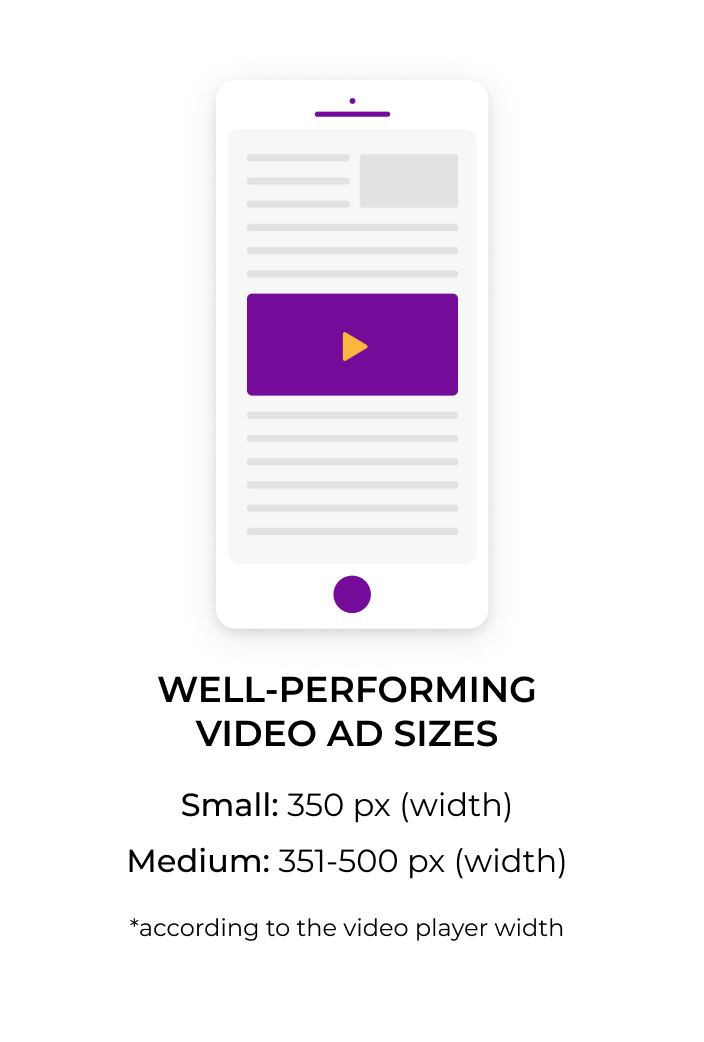 Video ads generally work 14% better in applications and 8% better on mobiles than desktops. On average, mobile video ads gather more shares and achieve better completion rates than desktop ads. So video advertising has a significant place in the field of mobile advertising.
Video ads generally work 14% better in applications and 8% better on mobiles than desktops. On average, mobile video ads gather more shares and achieve better completion rates than desktop ads. So video advertising has a significant place in the field of mobile advertising.
For instance, rewarded video ads that function only in apps give users incentives for ad-watching (in-game bonuses, items, etc.). In order to get the reward, users watch video ads instead of skipping them, which results in much greater completion and effectiveness.
Apart from rewarded ads, there are other popular mobile and in-app ad units like natives and interstitials.
Today video formats of online advertising are not limited by the ads on YouTube. Advertisers can easily use freshly-baked interactive creatives and channel them to particular audience groups through programmatic advertising.
By the way, the video ads shown in the player of some sites (YouTube, Twitch, Netflix) are in-stream video ads.
In-stream video advertising
There are different kinds of such ads:
Pre-roll: These ads appear before the video starts playing;
Mid-roll. Mid-roll ads are shown in the middle of the content. These ads are notorious for interrupting viewing;
Post-roll: Post-roll ads appear after the end of the video.
Out-stream video advertising
Out-stream ads are not dependent on the presence of a video player on the site or a specific page; they can appear between online articles or publications in the news feed. They are either placed within content or displayed as pop-ups.
Sizes of video advertising
Regarding the most popular video ad sizes, it's worth pointing out that they will depend on the width of the video player installed on the publisher's website. As a rule, small and medium video sizes (measured in pixels) don't irritate the view. This translates into a better user experience and explains why they are usually preferred over large ones.
Video ads significantly contribute to seamless user experience on the publisher's website and the effectiveness of online advertising campaigns. Here are a few tips to make them convert better:
- The right duration (between 15 and 30 seconds);
- Bright, engaging plot incentive;
- Vivid CTA.
Display ads
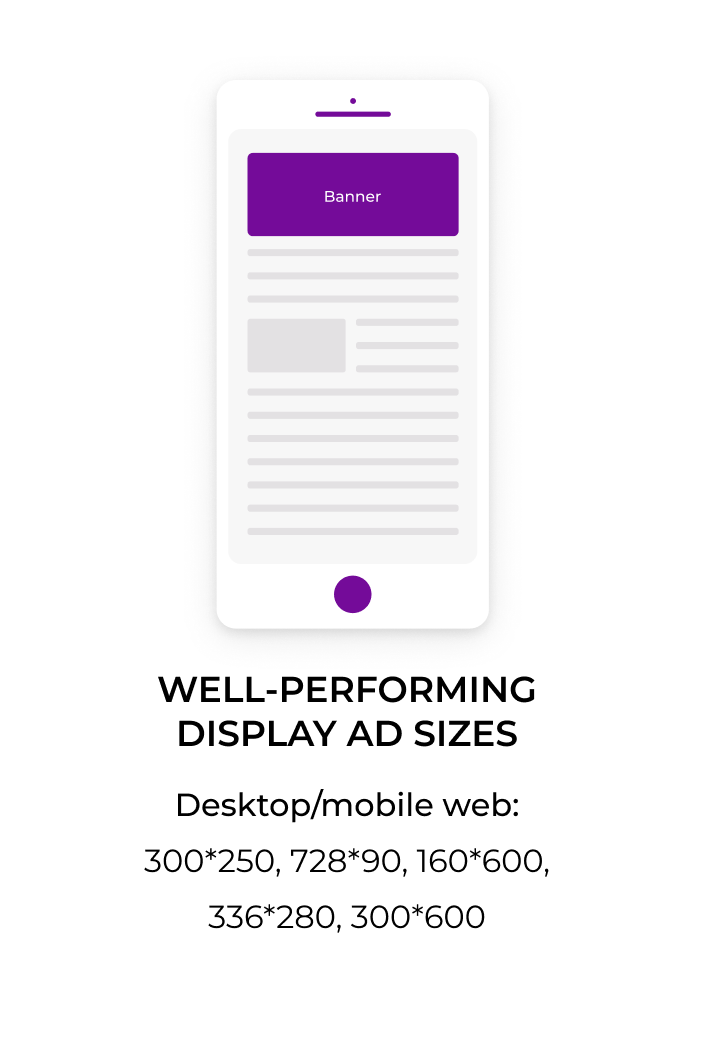 Display advertising is digital advertising that can incorporate an extensive pool of creatives: video and textual, including pop-ups, flash banners, animated and static images.
Display advertising is digital advertising that can incorporate an extensive pool of creatives: video and textual, including pop-ups, flash banners, animated and static images.
Advertisers usually choose banner ads because of their cost-efficiency and ease of use; they are supported on many platforms, mobile or desktop, and in various resolutions.
Different online advertising that belongs to the display kind usually generates relevant traffic as they are supported by various ad platforms with targeting functions and retargeting ad campaigns. The most famous of these would probably be Google Display Network by Google ads and Facebook by Meta.
Display ads can improve brand recognition, raise product awareness, and collect more leads during a digital advertising campaign. The main basis of serving display ads is choosing the right ad platform with targeting and equipping display creative.
Types of display advertising
Banners
These are a staple of online advertising strategies. Most often associated with Google Ads or other programmatic platforms like SmartyAds, they provide a range of predefined sizes and are a solid option for any campaign targeting a wide audience.
Responsive ads
If you're targeting a more specific audience, these ads are based on multiple formats that the algorithm places in various combinations. They include text headlines, descriptions, and images to convey your message. Don't forget about this type of online advertising when thinking about search engine marketing strategies.
Social media advertising
Similar to the previous type, these ads combine visual and text elements to focus attention on your CTA. The main difference is that they are placed on social media platforms.
Mobile advertising
Online advertising on devices and apps allows you to place web advertising on specific devices or in a single app category. This allows you to target in more detail, especially if you already know your audience and their habits.
Such online advertising can be placed in search results through Google Ads, in social networks through social media platforms, on publisher sites through programmatic platforms, etc.
Interstitial ads
Interstitial types of online display advertising are commonly used on mobile platforms and in applications.
Among the best online advertising types for a mobile platform, interstitial videos usually cover the whole user screen in-between game intervals, at the beginning of the app loading, or at the webpage loading.
After the banner ads are shown on the screen, their time expires, and they disappear. It is essential to let the user have the option to click on the ad immediately or close it right away.
The fact that banner ads and videos usually appear at logical interruptions makes interstitials less aggressive but immersive and memorable. Interstitials, on average, achieve 70% higher CTR than simple banners.
Interstitial-based online advertising campaigns will demand more advanced ad platforms with a higher capacity as a creative may have greater weight. It is recommended to serve interstitial ads programmatically and configure the asynchronous creative loading inside the app's settings. What's also important:
- Place the ads in the apps with the relevant subject;
- The app has essential intervals;
- Don't overstuff the app with ads (tune the frequency).
How interstitial online advertising is useful
Ideal for brand advertising. This format makes the users pay attention to the ad, which means they will at least remember the brand that placed it.
Good to attract attention. Since the ads cannot be closed or skipped, they will draw attention regardless of the user's desire. This is both good and bad at the same time because, on the one hand, the user's attention is in your hands, but on the other hand, the ad can irritate them. However, good creatives save from irritation.
Popular. Most advertisers call interstitial ads the most promising for mobile advertising.
Provide variety. Using new ad formats, you can show users a diversity of ads, minimizing the appearance of "banner blindness" and providing more interaction with the ads.
Expandable ads
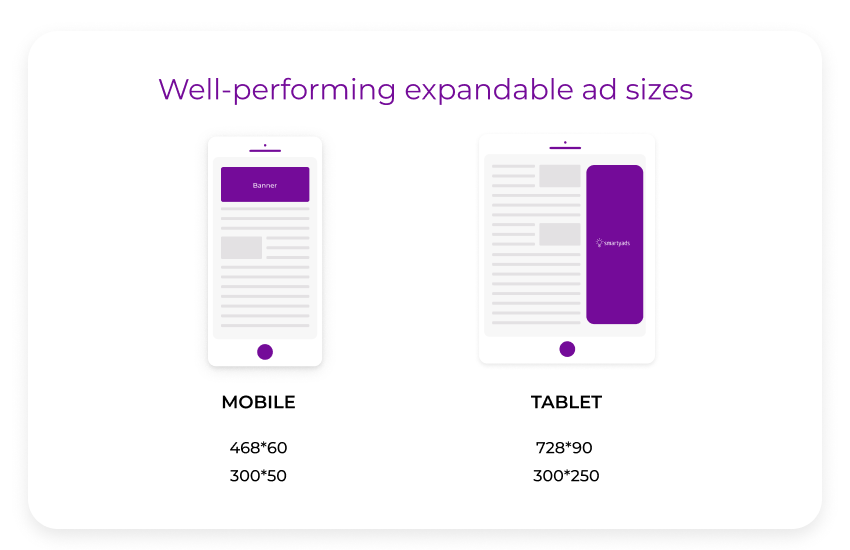 What are the best online ads that work best against "banner blindness" syndrome? Right, there's no match to expandable online ads when greater visibility should be achieved.
What are the best online ads that work best against "banner blindness" syndrome? Right, there's no match to expandable online ads when greater visibility should be achieved.
Expandable online ads typically appear in-app or on mobiles when triggered by the user's behavior, such as mouse hovering, clicking, or tapping at the adjacent area or page scroll.
Expandable banner ads may grow and reach larger dimensions when users activate them. Such online advertising is very memorable, interactive, and engaging; according to IAB, their engagement rate is 25% higher than average.
Expandable online advertising, however, can be highly annoying for users; that's why specialists recommend serving them through ad platforms, which can eliminate the frequency cap in the campaign settings. It's also important to:
- Set measurement for interaction and expansion rates;
- Make sure creative shuts with hover or click-off;
- Set the right timing for creative (around 5-10 sec.).
Benefits of Expandable Ads
Higher CTR: Because of action-oriented extensions, users tend to click on ads more often, which increases the chances of finally getting to the advertiser's landing page.
Encourage user activity: Expandable ads are designed to get clicks or responses from users. Also, when expanded, these ads can provide more details that increase brand awareness.
Ability to show more details: Expandable ads are designed for two states, and only interested users will click on the smaller one and move on to the larger ad size. This gives advertisers the ability to provide more details only to interested users.
We've reviewed the most popular 5 creative types most frequently used by advertisers. Now, let's take a look at the 3 rising stars - those formats that have gained the market by the landslide during the past years.
Audio ads
Programmatic audio is the automated placement of ads in online audio content such as podcasts, music streaming services, and digital radio. Like conventional programmatic buying, audio advertising also applies sophisticated algorithms to deliver the advertising message automatically. With all the necessary technical capabilities, programmatic audio embraces computers, cell phones, smart gadgets, and platforms in apps. In simple terms, audio programmatic duplicates the principles of "classic" programmatic.
How does audio advertising work?
The main obstacle to introducing audio software was the lack of clear specifications and standards. Not understanding exactly how audio ads could be delivered to audiences, advertisers and publishers neglected this channel.
At this point, the IAB developed DAAST (Digital Audio Ad Serving Template), which gave general audio advertising specifications, guidelines for execution, and reporting capabilities.
In November 2018, DAAST was combined with VAST 4.1 (Video Ad Serving Template), a protocol that bridged the gaps in the ad delivery of previous versions. It provides a connection between ad servers and SSPs with the ability to handle programmatic audio. The extensive protocol has been enhanced with an adType attribute and an audio ad script. The script explains how to place audio ads and what formats are available to marketers.
Audio Ad Formats
Linear audio ads. These contain all the standard placement options: Pre-Roll, Mid-Roll, and Post-Roll. Thus, commercial audio can be played immediately before or immediately after the audio stream (e.g., podcast) and in the online advertising section.
Related media advertising. These are static banners with the logo and CTA. Users can click on them throughout the audio advertising track.
Audio ad units. They are a set of sequential linear ads.
Skippable ads. These are Pre-Roll and Mid-Roll in audio files. Users can skip them, so the main purpose of these ads is to learn more about viewers' interests and what content they're listening to.
The in-app audio ads also support an audio-for-rewards format, in which users are asked to listen to a voice message in exchange for certain perks and bonuses, such as extra game currency or the option to skip a level. The user chooses whether to listen to the ads or not, so such ad units are characterized as unobtrusive and positively received by listeners.
DOOH ads
Out-of-Home (OOH) advertising is a traditional (i.e., not digital or programmatic) form of advertising contact outside the home. It implies an appeal to customers in a public space (on the street, in transportation, etc.).
Among the most common out-of-home media formats are billboards, public transport stations, carriers, etc.
DOOH is essentially the same OOH advertising but technologically "pumped up" (geo-fencing, tracking, retargeting, personalization, attribution), so it's become digital advertising.
Benefits of DOOH
Targeting
While there is no way to target an ad exclusively to an audience of a few dozen people (rather than a hundred random viewers), algorithmic media buying at least allows DOOH ads to be shown at a time when the likelihood of the target audience being near the advertising medium is highest.
Measurements
An advertiser targets a specific user with a cookie or device ID on the Internet.
In DOOH, it doesn't work that easily. For a DOOH campaign, geolocation data from explicitly enabled users is critical.
Today, many marketers use mobile geo-analytics to measure DOOH.
Some analytics providers, such as Placed (owned by Snap Inc.), match user location data (clearly allowed to collect such information) with online ads and evaluate the success of such ads. With access to data from users of its products, Snap Inc. tracks the activity of about 150 million devices and knows how ads on their services affect purchases.
Snap Inc.'s multi-channel attribution capabilities include an early attribution implementation in DOOH. Its first working example was the "Snap To Store" tool, which can match point-of-sale traffic to ads in Snap Inc. services.
Retargeting
Although individual targeting is not available in DOOH, it is possible to set up retargeting of ads to smartphones.
For example, operators can use a geo-fence (i.e., create a virtual boundary around an advertising medium using GPS or radio frequency identification) to trigger a response when a mobile device enters (leaves) an area near an advertising structure.
In this way, operators can send personalized messages to anyone who happens to be near the advertising medium. This is not science fiction: Clear Channel Outdoor has been retargeting ads to smartphones in the U.S. using its proprietary Radar platform.
This system uses aggregated, depersonalized mobile data from third-party vendors that comply with privacy requirements to gain insights into the nature of how certain audience segments move around town and offer DOOH the media best suited to reach those people.
A high level of attention-grabbing
Advertisers and agencies can take advantage of the basic benefits of DOOH to increase awareness and conversions.
Over the past decade, engagement with online advertising has been declining and has reached the point where click-through rates for many formats have become less than one percent. This state of affairs has been caused by the bombardment of users with online ads and the resulting proliferation of ad-blocking tools along with banner blindness.
In-game ads
In-game advertising is a type of monetization by selling advertising space in games. The different formats of such advertising have one goal: to attract the player's attention without interrupting the gameplay.
In-game advertising can increase purchase intent by up to 12%. For example, 81% of ad buyers in the U.K. and U.S. say they will increase their spending on in-game ads in 2024.
How in-game advertising works
This method of monetization works when advertisers buy online advertising space in the game. Ads can be integrated directly into the game or shown as banners.
Developers can offer a free user experience by creating content they like. It comes with ad revenue from in-game apps. But this way of engaging users is also effective for advertisers: to attract new consumers to their products, services, or other applications.
In-game online advertising formats
Static in-game online advertising
Static ads are programmed directly into the game during the development phase. Ads in static in-game ads cannot be changed. Like product placement in a movie or music video, static ads often appear on billboards or signs. Given the fact that these ads cannot be changed, they are not as popular as dynamic ads.
However, static in-game ad rates continue to rise because new iterations of previously released games provide more customization options. Static ads are expected to generate $6,365.3 million in revenue by 2028.
Dynamic in-game online advertising
Unlike static ads, dynamic ads are banners displayed in-game that can be updated in real-time. Dynamic in-game advertising gives advertisers greater flexibility and easy scalability. It can also be used to geo-target users who have signed up for the newsletter.
Another reason for the popularity of dynamic ads with advertisers is the variety of ad formats.
The most popular formats of dynamic in-game online advertising:
- Cross-page ads;
- Native banners;
- Contextual advertising;
- Rewarded video ads;
- Video ads with a demo.
All types of online advertising: launching
Different forms of online advertising demand diverse approaches. The thing is, programmatic today can serve the most effective kinds of Internet advertising automatically, empowered with RTB protocol.
Advertisers pay for using a self-serve DSP platform that connects them to the publishers who use holistic SSP from their side to access the demand side. Each party uses dashboards that allow automating deals, accepting only those that meet their preferences.
Advertisers choose what types of online advertising to serve, where and how to target, who should be viewing the ad (target demographics according to geolocation, IP, browser, etc.), and configure the budget spending options.
The publisher is also able to choose what types of online advertising to accept and serve on the landing pages, their sizes, and positions, and set the floor price under which the deals won't happen.
This way, the platform becomes the tool that matches the right inventory to the right online ads and helps to gain control over the placements and audiences.
If it is a long-term online marketing strategy, it will most definitely require using different types of online advertising, each added gradually for the new campaign or user segment. Some online ads will be added, and others will be cut out as you test them, obtain the stats, and identify the most optimal creative options for you.
To sum it up
Different types of online advertising can give you various benefits. Remember that these types of advertising can be used simultaneously, as many of them can complement and reinforce each other. Always keep analytics in mind and research the success of your advertising campaigns in numbers.
The most successful campaigns are made up of a smart strategy combined with good creative, so it's worth paying close attention to the visual presentation of your ads as well.
With SmartyAds, you can run various ad campaigns to accelerate your brand's growth.



